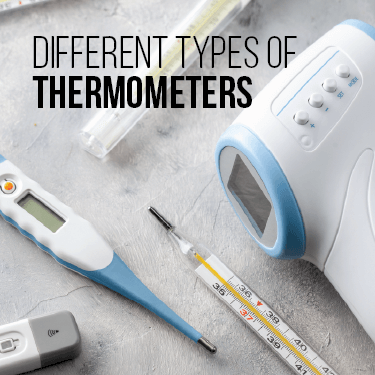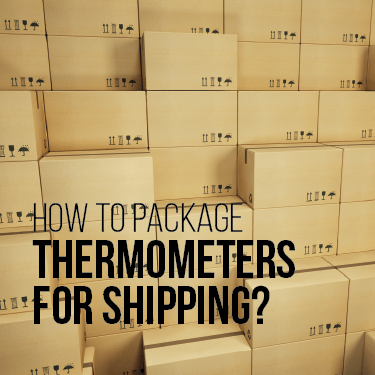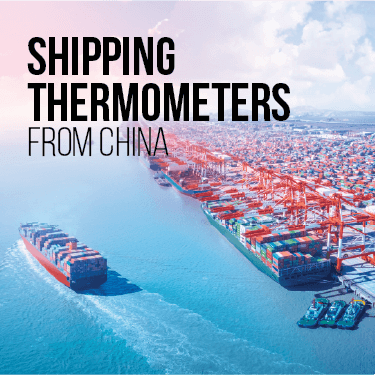Suddenly a hot commodity to see if you’re running a fever, shipping thermometers and their counterparts known as temperature scanners is an absolutely crucial part of making sure the people who need them are able to get them. But perhaps the finer points of how to set up a freight load or knowing about the requirements prior to selling them elude you.
Thankfully, with some care taken during the package and shipping, some insight into market conditions that can affect the products’ arrival and making sure your goods are approved by the Food and Drug Administration (FDA) before attempting to distribute them, you’ll be well on your way to being a success overall, especially in shipping thermometers.

Largely manufactured in China, thermometers range from many adults’ first usage of a standard mercury thermometer that has to be placed in the mouth or elsewhere to completely contactless digital temperature scanners that are battery powered and can give an accurate reading almost instantaneously. These are considered a basic item to have in a household or a veritable medical supply.
But while every type of thermometer has the same basic function — to take a person’s temperature — they still come in many distinct variations that people prefer to use based on how they acquire the important health information.
The mercury thermometers that take temperature internally will be the cheapest option but are the slowest at recording its reading while needing to be used internally and sometimes in the exact right position to output an accurate reading. These aspects of a mercury thermometer don’t necessarily make it a suboptimal option but it’s necessary to consider.
Digital and infrared thermometers are each alternatives and becoming popular to use. Infrared devices have been particularly popular since the COVID-19 outbreak because they can assess a person’s temperature without contact needed. They are also just as accurate as internal thermometers — glass or digital — without the uncomfortable aspects of those two.
When referring strictly to a digital thermometer, this can be a simple oral one under $10 that works in the exact same way as a glass thermometer but outputs the number on a basic digital screen on the thermometer. Digital thermometers are also used internally since they are pretty similar to traditional glass ones.
To talk more about infrared thermometers, these are for external use and can either be pressed against a user’s skin around the temple, or be completely free of any contact, picking up the correct temperature from inches or even feet away. Basic ones found at a pharmacy might be more than a strictly digital thermometer and need battery power (either traditional or an internal lithium ion battery that can be recharged many times) in order to operate.
Pretty much all infrared thermometers are also referred to as digital. The easiest way to determine the difference is that all infrared thermometers are digital but not all digital thermometers employ infrared technology.
Need help shipping glassware like thermometers? Check out our article How to Ship Glassware Without Shattering Expectations.
While these are in their own category for reasons to be explained shortly, temperature scanners have the same general function as their thermometer counterparts. However, the differences stem from where they are used, as well as their size and cost.
Temperature scanners are set up at places like businesses, hospitals and other medical facilities and airports as the world tries to adapt to the enhanced need for such a setup. In fact, some Las Vegas casinos have implemented thermal scanners that can tell within a matter of seconds if a patron has an elevated body temperature or not.
Yet all of these differ in size and shape. In an airport or a retail store, it might be in the form of a vertically oriented screen attached to a base so it can stand freely in an aisle or entrance in order to screen entrants upon arrival. At a place of business, some are using wall-mounted scanners that you place your head near and give a fast reading.
Regardless of which kind you encounter, they are going to be bigger and more electronically complex than a comparatively primitive thermometer designed for home usage or one-on-one interactions at a doctor’s office. This also makes the temperature scanners more expensive per unit. No matter which one you use, it’s also as important to know how to take your temperature once it’s time for that.

A quick note before we dive into packaging: you must get your thermometers and temperature scanners approved for use by the FDA before you can even think about buying and shipping them. If you’re not the manufacturer and are instead a wholesaler or business, this can actually be as simple as checking to see if the products in question have been approved. It covers your bases and gives you a peace of mind that you’re not illegally importing or shipping these goods.
As far as the packaging of digital thermometers and temperature scanners go, it’s similar to a lot of other consumer goods. Chances are the manufacturer will put it in a personalized container, such as a size-appropriate cardboard box, and include packaging materials like a thin plastic to encompass the object and protect against moisture, and more cardboard in the box to stabilize the thermometer from moving around and also adding additional protection against any impact damage.
For temperature scanners that will be bigger and more valuable, even more care is taken. Styrofoam specially formed to encase the temperature scanner will be the norm and it’s even likely that stronger corrugated cardboard boxes will be used for the added protection it can offer. Regardless, since these are all breakable items and very likely will be traveling a great distance before they’re loaded into the truck, sufficient packaging is a must to protect these goods during transit.
Whether mass shipping a bunch of smaller thermometers or bigger temperature scanners, it’s a near certainty that you’ll be having items with electronic components being transported. Also, while most basic thermometers are made out of plastic externally, it is not indestructible. So care will have to be taken while they’re riding in the back of a truck.
Since packaging the thermometers and temperature scanners was covered in the previous section, let’s focus on the loading and riding aspects. No matter what kind of temperature takers are being shipped, they will likely need to be placed on pallets, shrink wrapped onto the pallet to secure the boxes and loaded via forklift and pallet jack onto the truck.
That goes for all of the devices. Boxes for freight shipping will be comparable sizes with the main difference being the amount of items in a single shipping box.

Since it was mentioned earlier that the majority of thermometers are produced and imported from China, it’s helpful to know a few aspects about that which will impact when your temperature-taking equipment can finally get on a truck on U.S. soil and begin its final journey to retailers for consumers to buy or to other places that want the machines for a specific purpose.
American wholesalers can expect a lengthy lead-in time. With the current state of affairs, which includes delays due to COVID-19, it could be a month or more from the time your order is placed, the products are produced and they’re finally loaded onto an ocean freighter or, in increasing cases, a cargo plane.
If the thermometers or temperature scanners are on a cargo plane, it will be much more expensive but you can expect the freight to arrive within days, even factoring in any added delays. However, ocean freighters can take up to two months to make it from China to its likely port of entry on the west coast of the U.S. The two most popular places for goods from Asia to make land are Long Beach/Los Angeles in California — by far — and also Seattle in Washington state. But depending on the market conditions at the time of your order, it could take even longer because of freight shipping delays.
This information might not affect the actual on-the-road shipping once the thermometers reach America. Yet, it can help in the planning of the timeframe it will take to get them here and then get them into the hands of the people who are clamoring for them.
Now that you know the ins and outs of freight shipping thermometers and temperature scanners, it’s the perfect time to pick up the phone and give R+L Global Logistics a call to find out about partnering with them for all of your transportation needs. Whether these items that measure temperature originate from overseas or are produced domestically, our trucks will get them where you need them.
Whether your thermometers are fragile or sturdy, R+L Global Logistics can appropriately handle them the correct way during the loading, shipment and unloading processes to ensure these necessary medical devices show up in pristine condition. That’s just the level of care and thoughtfulness each one of our freight loads receives as a common courtesy.
R+L Global Logistics is also completely committed to making sure your thermometers are delivered on time, which is reflected in our 99.5 percent on-time delivery rate for anything we ship. So you can rest assured that any temperature-taking device will be handled not only with care, but in an expedient manner as well.
Whether your thermometers are produced in America, a nearby foreign country like Canada or Mexico or even overseas, R+L Global Logistics can help you with the part of the journey where tires meet the pavement. In that regard, it’s possible that our expedited freight shipping could really prove to be valuable to your business. With expedited, we can shorten the length of a trip by a day or two depending on the overall distance needed to be traversed.
R+L Global Logistics prides itself on being a good value proposition for its customers, which is why we include industry-leading customer service and real-time freight visibility with each and every load we agree to transport. So whether you just want an accurate approximation of where your goods are at any given moment, or simply want to talk to a real person about any aspect of your thermometers’ journey, we can easily accommodate you.
So when freight shipping thermometers and temperature scanners are on your radar, link up with the best around at R+L Global Logistics. For a free quote, call us at 866.353.7178.
R+L Global Logistics
315 NE 14th St., Ocala, FL 34470